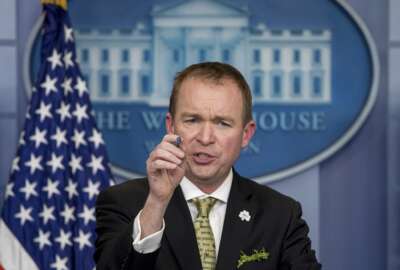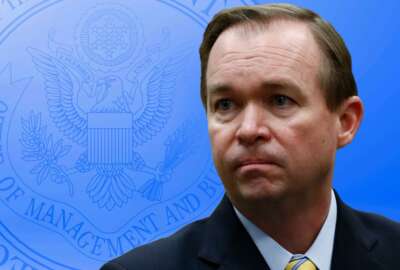

Former chief human capital officer at DHS explains how Office of Management and Budget Director Mick Mulvaney's reorganization memo impacts agencies and their...
This column was originally published on Jeff Neal’s blog, ChiefHRO.com, and was republished here with permission from the author.
Last week, Office of Management and Budget Director Mick Mulvaney published a new memo (OMB M-17-22) to agency heads titled “Comprehensive Plan for Reforming the Federal Government and Reducing the Federal Civilian Workforce.” When people read the memo, the lede was something along the lines of “Trump lifts hiring freeze.” Later, folks started noticing other parts of the memo, including its focus on dealing with poor performers. There is actually a lot of news in the memo’s 14 pages, so let’s break it down and see what it really says.
“Begin taking immediate actions to achieve near-term workforce reductions and cost savings, including planning for funding levels in the President’s Fiscal Year (FY) 2018 Budget Blueprint.”
The key word here is “begin.” Later in the memo (page 10) it says:
“To support the goals of the FY 2018 President’s Budget Proposal, OMB directs agencies to identify workforce reductions over a four-year period (FY 2018 through 2022) consistent with discretionary outyear levels included in the FY 2018 Budget this spring and forthcoming OMB guidance on FY2019 Budget submissions. Agencies should begin planning for these reductions now, as achieving associated personnel reductions takes time to implement and realize savings.”
Even though the president’s “skinny budget” proposed large reductions in employees in Fiscal 2018, the new memo appears to recognize that it is too late to do widespread reductions in force this year or next. An agency running a RIF (reduction in force) would need to get people off the payroll very early in the fiscal year to have any chance of realizing savings from the RIF. The longer they wait, the less likely they are to save anything. In fact, running a RIF later than the first quarter of the fiscal year would likely cost an agency more than it would save by getting the employees off the payroll. That is due to the costs of severance pay, buyouts and lump-sum annual leave payments. Spreading the reductions over several fiscal years is more prudent and could be accomplished with far less disruption.
“To facilitate any necessary reductions, [Office of Personnel Management] will provide streamlined templates to agencies for requesting approval to offer Voluntary Early Retirement Authority and Voluntary Separation Incentive Payments (VERA/VSIP) and OPM will provide expedited reviews for most requests within 30 days. However, eliminating unnecessary vacant positions can begin immediately” (emphasis added).
There are two key points here. First, there is clearly an intent to use early retirement and buyouts to mitigate the effects of reductions. That is good news. Second, the administration expects agencies to start reducing now. That means an agency that is projected to have large reductions is going to be expected to show results in this fiscal year. For those agencies, the hiring thaw is going to revert right back to a hiring freeze of some sort. We have already seen that in State and other agencies. I know some folks believe the agencies should wait until the budget is passed before they start making cuts. However, if they keep hiring until they have a firm budget, they are likely to find themselves in a deeper hole.
“Develop a long-term workforce reduction plan.”
Again we see the emphasis on “long term.” The memo requires agencies to determine what the right numbers and grades of employees should be, rather than simply looking at previous budgets. It directs agencies to revise their organizations, delayer them and pay particular attention to “deputy positions, lower level chief of staff positions, special projects, and management analysts that may duplicate the work performed in such areas as procurement, human resources, and senior management.” This section was written by someone who has worked in the federal government. That last section was a direct swipe at the “shadow” staff in many agencies that act as go-betweens between managers and service providers. The Trump administration is not the first to try to solve the “shadow office” problems. My guess is they will not be the last. Playing whack-a-mole with shadow staffs is bureaucratic game that is rarely satisfying to any of the participants.
Shared services also get a mention in the memo. As I have written before, there is a good case to be made that the government buys the same services far too many times. Agencies are encouraged to look at “alternative service delivery models” and to “streamline mission support functions.” There is nothing new in that recommendation, but the memo does encourage use of outsourcing, insourcing and other options that would provide “greater efficiency while maintaining or improving quality.” The nod to insourcing is a bit of a surprise, but given that some of the better shard services organizations are in government agencies, it is a good idea. The overall move to more shared services is sound, and is a good example of using a business-like approach that can work effectively. The memo also encourages use of “Best in Class” contract vehicles. It avoids the false binary choice between insourcing and outsourcing and recognizes that there are many ways to deliver shared services effectively. Those who are argue such work should always be done in-house may be unhappy, as might a handful of large companies that advocate for outsourcing everything to them. All told, this section of the memo is a commonsense approach that should not draw too much criticism.
“Streamline policy creation by eliminating the common tendency to recraft/restate policy for a component or regional office.”
Another provision written by someone with experience in government, this one is addressing the all too common tendency of people at every level of an agency to create “policy” documents that are not policy and are rarely necessary. It is a good way to eliminate unnecessary work.
“Plan to maximize employee performance.”
This section focuses on steps agencies can take to increase performance, with the emphasis very heavily on dealing with poor performers. Among other things, it requires agencies to update their policies on dealing with poor performance and conduct, limiting the use of administrative leave, providing transparency in the performance improvement plan (PIP) process, training managers and supervisors, building accountability in manager performance plans, and establishing “real-time manager support mechanisms.” All of those are reasonable proposals, but that last part is the most significant. One of the biggest problems with dealing with poor performance and misconduct is that managers often get no support when they try to do it. Senior political appointees often want no controversy, so they want problems to just go away. Lawyers often want to settle every case. Every step of the way, there is another hurdle. it is no wonder that dealing with poor performers is a perennial issue in the Federal Employee Viewpoint Survey. These support mechanisms have a good chance of making a difference and are an excellent idea.
While dealing with poor performers is a great idea and would probably win praise from a wide range of people, what was missing from the memo is dealing with good performers. The percentage of federal employees who should be fired because of their conduct or performance is most likely small. Even if we take a huge percentage — say 10 percent — that are problem employees, then deal with them effectively, we are left with the remaining 90 percent. Those are the folks who get the government’s work done. How they are doing, and how they are treated, is more likely to have a significant impact on government performance. Even if you take into account the demotivating effect of poor performers, the fact is that the good employees do the work. They need good training. They need recognition when they do a great job. They need to be treated as the valuable contributors that they are. Good employers in the private sector recognize that an act accordingly. Let’s hope there is more to come on this issue.
Jeff Neal is a senior vice president for ICF and founder of the blog, ChiefHRO.com. Before coming to ICF, Neal was the chief human capital officer at the Homeland Security Department and the chief human resources officer at the Defense Logistics Agency.
Copyright © 2025 Federal News Network. All rights reserved. This website is not intended for users located within the European Economic Area.



